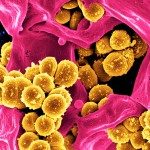Lien vers Pubmed [PMID] – 23840553
PLoS ONE 2013;8(6):e66908
RanBP9 is known to act as a scaffolding protein bringing together a variety of cell surface receptors and intracellular targets thereby regulating functions as diverse as neurite and axonal outgrowth, cell morphology, cell proliferation, myelination, gonad development, myofibrillogenesis and migration of neuronal precursors. Though RanBP9 is ubiquitously expressed in all tissues, brain is one of the organs with the highest expression levels of RanBP9. In the neurons, RanBP9 is localized mostly in the cytoplasm but also in the neurites and dendritic processes. We recently demonstrated that RanBP9 plays pathogenic role in Alzheimer’s disease. To understand the role of RanBP9 in the brain, here we generated RanBP9 null mice by gene-trap based strategy. Most of Ran-/- mice die neonatally due to defects in the brain growth and development. The major defects include smaller cortical plate (CP), robustly enlarged lateral ventricles (LV) and reduced volume of hippocampus (HI). The lethal phenotype is due to a suckling defect as evidenced by lack of milk in the stomachs even several hours after parturition. The complex somatosensory system which is required for a behavior such as suckling appears to be compromised in Ran-/- mice due to under developed CP. Most importantly, RanBP9 phenotype is similar to ERK1/2 double knockout and the neural cell adhesion receptor, L1CAM knockout mice. Both ERK1 and L1CAM interact with RanBP9. Thus, RanBP9 appears to control brain growth and development through signaling mechanisms involving ERK1 and L1CAM receptor.
